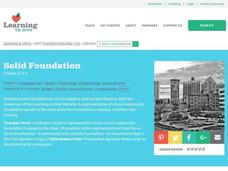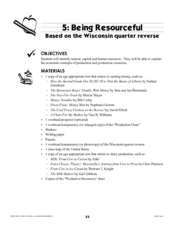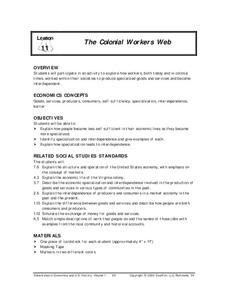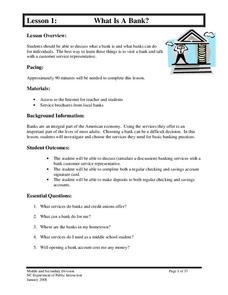Curated OER
Why We Trade: Exchanging Goods and Services
Students conduct simple bartering and trading activities and consider how product value can be altered by the market.
Curated OER
Let's Make Lemonade
Young scholars generate a list of needs for a community project. In this social studies and philanthropy lesson plan, students listen to the story The Little Red Hen and discuss teamwork. Young scholars plan for a lemonade stand,...
Curated OER
Economy Introduction: Jack and the Bank Stock
Third graders explore the functions of money. In this economics lesson, 3rd graders read Jack and the Beanstalk to discover the three main functions of money.
Curated OER
Academic Service Learning: Creating the Philanthropy Resource
Students complete a service learning project. They interview non-profit organizations of their community and develop listing information for each organization. They also develop a list of career opportunities for the community.
Curated OER
Market Simulation
Students explore the role of markets in Asian countries. They bring items from home to barter with to simulate markets. They discuss the advantages and problems of exchanging and how price is determined.
Curated OER
Chapter 2: The Economizing Problem
It doesn't take a lecture on economics to convince teenagers that one's wants often exceed one's means, but this presentation will hopefully help them to understand the discrepancy. Using an example of pizza and robot arms, the slides...
Council for Economic Education
Production Possibilities Curve
Demonstrate the important economic principles of the production possibilities curve, including how to calculate opportunity cost and graph curves by using a table or calculation. Learners use a variety of methods, including videos,...
Drexel University
Learning Roomba Module 5: Localization
Where is my robot? Pupils create programs that utilize the localization services that a Roomba uses to determine its surroundings.
PBIS World
Referral to Behavior Specialist
Enhance the communication between professionals with a behavior specialist referral form. With fields that address parental concerns, previous interventions, and services requested, the form is a great resource for helping kids be...
Curated OER
Solid Foundation
Young community members explore philanthropic foundations. They discuss the work of community foundations, and then they listen to a guest speaker describe the vision and activities of a local foundation. Is there a way they can join the...
Curated OER
Bartering in Jamestown
Young scholars explore bartering. In this bartering lesson, students study everyday life in the Jamestown colony. Young scholars discover how bartering was used as a way to acquire necessary supplies.
iCivics
Responsibility Launcher
So how would pupils solve a town's problems? Using a video game, scholars tell residents of a town how to solve their problems by taking steps such as going back to school, voting, or serving in the military. As they make good choices,...
Curated OER
Being Resourceful: Wisconsin quarter reverse
If your class understands goods and services then they'll be ready for this lesson on various resources. After reading a series of books and engaging in class lecture and discussion, pupils will fill out worksheets. They will list...
Curated OER
Growing as a Group
Students design a plan to help families who are in need. For this citizenship lesson, students brainstorm and implement a service project in their own community. Students discuss how to provide food for families who are in need.
Federal Reserve Bank
Once Upon a Dime
The story of "Once Upon a Dime" starts like any other fairy tale, but it quickly becomes a story about the value of money and the economic system commonly used before it. Presented as a cartoon, the resource consists of dialogue between...
Curated OER
Wampum
Students explore different ways of trading to get what they want. In this algebra lesson plan, students explore goods, money, services and exchange. They compare the use of money to the use of potlach.
Curated OER
The Colonial Workers Web
Students explore how workers, both today and in colonial times, worked within their societies to produce specialized goods and services and became interdependent. They explain how people became less self sufficient in their economic...
Curated OER
Class Store
First graders explore economics by participating in a group activity. In this commerce lesson, 1st graders conduct a role-playing activity in which they utilize goods and services to re-enact a general store's daily business. Students...
Curated OER
Where Do You Shop?
Students examine shopping patterns in another community to develop a hypothesis on why there are more opportunities for goods and services in some neighborhoods while others lack these goods and services.
Curated OER
Triangular Trade and Its Effects
Students investigate the trade routes and investigate goods and services were transported along each route. Given a primary source document, that represents a personal story related to the triangle trade, they discuss given questions.
Curated OER
Spending Money
Fourth graders become familiar with the ways people exchange goods and services. In this spending money lesson, 4th graders listen to a chapter from Henry and Beezus and record Henry's earnings and money spent. Students use correct...
Curated OER
Debit or Credit-You Decide
Students identify the similarities and differences between an debit and credit card. In this debit or credit lesson plan, student explain the advantages and disadvantages of using cash and consumer credit to purchase good and services...
Curated OER
Making Good Money Choices
Students identify the needs of their community. In this communities lesson, students use a decision-making model worksheet to determine what community service project they should donate to. Students count the money they have to donate...
North Carolina Department of Public Instruction
What Is A Bank?
You're never too young to learn about banking and personal finance. Use a set of seven banking lessons to teach middle schoolers about checking and savings accounts, interest rates, loans and credit cards, and safety deposit boxes.

























